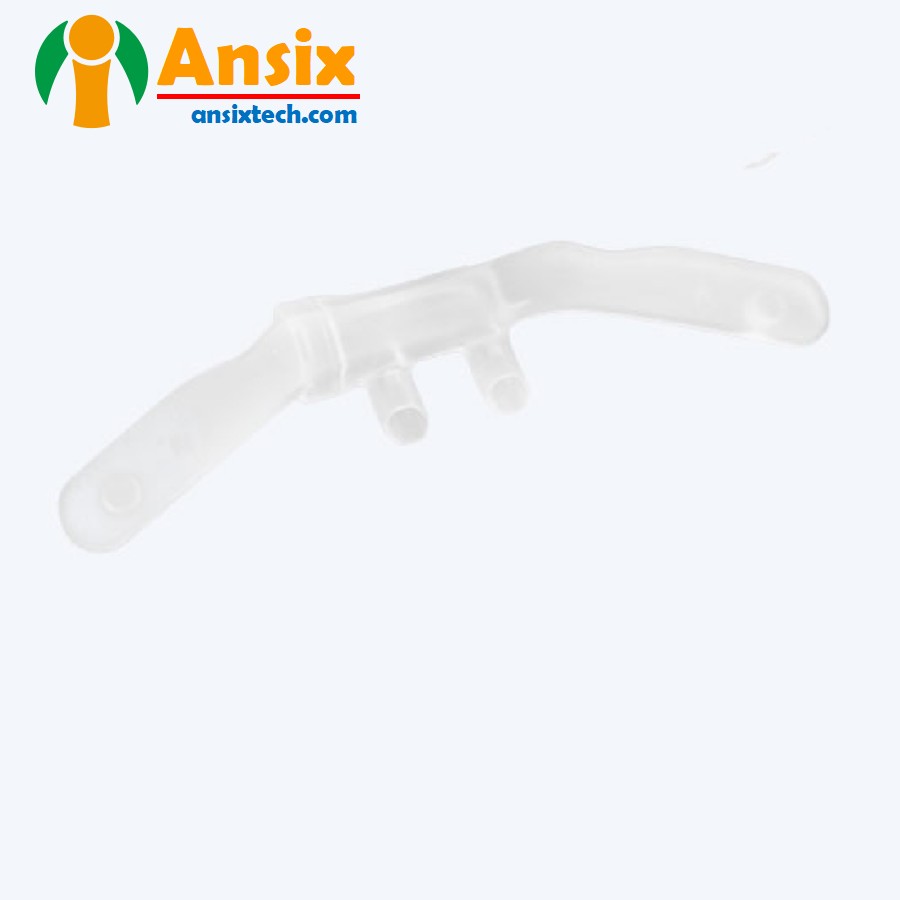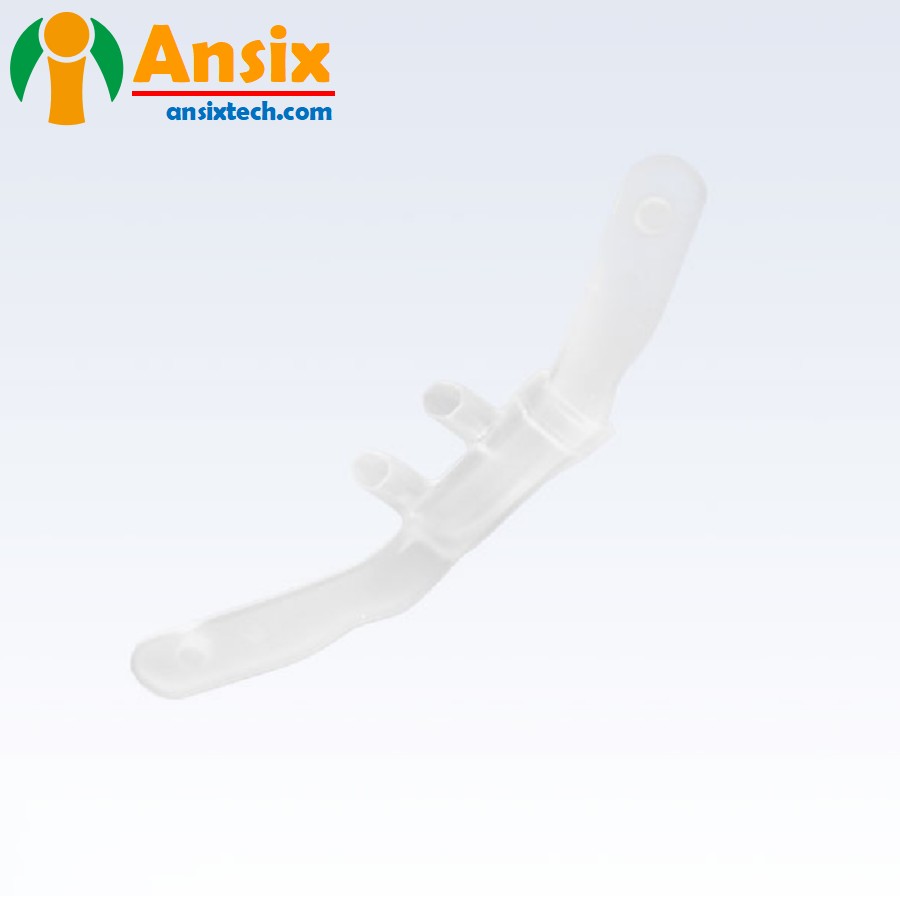AnsixTech liquid silicone tube
FEATURES
- Two component 2K molding for handle
AnsixTech liquid silicone tubing has a wide range of applications. First, it is widely used in the medical field, especially in medical devices and medical equipment. Liquid silicone tubes have good high temperature resistance and corrosion resistance and can be used to transport high temperature liquids or chemicals to ensure the normal operation and safety of medical equipment. Secondly, liquid silicone tubes can also be used in the food and beverage industry. Liquid silicone material is non-toxic, odorless, meets food safety standards, and can be used to transport food and beverages to ensure product hygiene and quality. In addition, liquid silicone tubes can also be used in industrial fields, such as chemical, electronics, automobile and other industries, to meet the pipeline needs in various special environments.
-
Mold Description
Product Materials:
ShinEtsu、Dow
Mold Material:
S136
Number of Cavities:
1*4
Glue Feeding Method:
Hot runner
Cooling Method:
Water cooling
Molding Cycle
16.5s

- Liquid silicone tube Mold flow analysis and mold designThe design of medical liquid silicone tube mold needsMold structure design:According to the shape and size requirements of the liquid silicone tube, design the appropriate mold cavity and mold core to ensure that the liquid silicone can fully fill the mold cavity and form the required tube shape.Taking into account the fluidity of liquid silicone gel, design appropriate guidance and cooling systems to ensure the filling performance and solidification effect of liquid silicone gel.Taking into account the demoulding requirements of the liquid silicone tube, design an appropriate demoulding system to ensure that the liquid silicone tube can be demoulded smoothly and avoid damage and deformation.Injection molding process design:According to the characteristics of liquid silicone, determine the injection molding process parameters, including injection speed, temperature, pressure, etc., to ensure the filling performance and curing effect of liquid silicone.Determine the injection sequence and injection point location to ensure that the liquid silicone can fully fill the mold cavity and avoid voids and defects.Mold material selection:Choose mold materials with good wear resistance, high temperature resistance, and corrosion resistance, such as high-quality steel or special alloy materials, to ensure the service life and stability of the mold.Considering the characteristics of liquid silicone, select mold materials that are compatible with liquid silicone to avoid chemical reactions or adverse effects with liquid silicone.Mold manufacturing and debugging:According to the mold design, process and assemble the mold parts to ensure accurate fit and adjustment of the parts and ensure the stability and reliability of the mold.Carry out debugging and optimization of the mold to ensure that the filling performance, curing effect and demoulding performance of the mold meet the requirements.In the design process of medical liquid silicone tube mold, you need to pay attention to the following points:Ensure mold accuracy and dimensional control to ensure the quality and stability of liquid silicone tubes.Reasonably design the cooling system to improve production efficiency and product quality.Considering the hygiene and safety of medical liquid silicone tubes, select mold materials and processing techniques that comply with relevant standards and certification requirements.Establish a complete quality control system, including quality inspection, process control and defective product processing, to ensure that products meet quality standards.To sum up, the design of medical liquid silicone tube mold needs to comprehensively consider factors such as mold structure, injection molding process, mold material selection and mold manufacturing. Through reasonable design and control, high-quality medical liquid silicone tube production can be achieved.


- Liquid silicone tube of the mold manufacturing process and product material selectionThe manufacturing and processing of medical liquid silicone tube molds and the selection of liquid silicone materials are very important links in medical device manufacturing. The following will introduce the manufacturing and processing of medical liquid silicone tube molds and the selection of liquid silicone materials.Manufacturing and processing of medical liquid silicone tube molds:a. According to the design requirements of the liquid silicone tube, formulate the mold manufacturing and processing process, including mold design, mold processing, mold assembly and other links.b. According to the mold design, select appropriate processing technology and equipment, such as CNC machining center, EDM machine, etc.c. Process mold parts, including mold cavity, mold core, demoulding system, cooling system, etc. Ensure that the processing accuracy and size meet the requirements.d. Assemble the mold parts to ensure accurate fit and adjustment of the parts and ensure the stability and reliability of the mold.Selection of liquid silicone materials:a. Select the appropriate liquid silicone material according to the requirements of medical liquid silicone tubes. Commonly used liquid silicone materials include food-grade silicone, medical silicone, etc.b. According to the use environment and requirements of the product, select liquid silicone materials with good mechanical properties, high temperature resistance, chemical resistance and wear resistance.c. Considering the hygiene and safety of medical liquid silicone tubes, choose liquid silicone materials that meet relevant standards and certification requirements.During the manufacturing and processing of medical liquid silicone tube molds and the selection of liquid silicone materials, the following points need to be noted:Processing accuracy and size control: Ensure that the processing accuracy and size of mold parts meet the requirements to ensure the quality and stability of injection molding.Surface treatment of the mold: According to the requirements of the liquid silicone tube, perform appropriate surface treatment, such as grinding, polishing, etc., to improve the surface quality and smoothness of the tube.Control of injection molding process parameters: According to the characteristics of liquid silicone, rationally design and control the injection molding process parameters to ensure that the fluidity and solidification time of the silicone meet the requirements.Material selection and certification: Select liquid silicone materials that meet relevant standards and certification requirements to ensure product safety and hygiene.The manufacturing and processing of medical liquid silicone tube molds and the selection of liquid silicone materials require the selection of appropriate processing techniques and equipment to ensure processing accuracy and dimensional control.exist
- Liquid silicone tube mass production and Quality controlThe mass production of injection molding of medical liquid silicone tubes involves considerations such as process, production efficiency, cost control, quality assurance and packaging.Process:Injection molding process parameter optimization: Through experiments and actual production verification, the injection molding process parameters, including injection speed, temperature, pressure, etc., are optimized to ensure the filling performance and quality stability of the liquid silicone tube.Mold temperature control system: ensure the stability and uniformity of mold temperature to improve the molding quality of liquid silicone tubes and reduce defects.Injection molding sequence and injection point position: Determine the injection molding sequence and injection point position to ensure that the liquid silicone can fully fill the mold cavity and avoid voids and defects.Production efficiency:Automated production: Use automated injection molding machines and robotic systems to achieve automated production, improve production efficiency and reduce labor costs.Multi-cavity molds and multi-machine production: Use multi-cavity molds and multiple injection molding machines for simultaneous production to increase output and production efficiency.Production plan and schedule optimization: Develop reasonable production plans and schedules, and rationally arrange production tasks and resources to improve production efficiency and reduce production downtime.Cost control:Material cost control: Select appropriate liquid silicone injection molding materials, and conduct procurement and inventory management based on actual needs to control material costs.Equipment and energy cost control: Use equipment rationally, optimize energy consumption, and reduce equipment maintenance and energy costs.Labor cost control: Reduce manual operations and reduce labor costs by automating production and optimizing the production process.Quality assurance:Establishment of quality control system: Establish a complete quality control system, including quality inspection, process control and defective product processing, to ensure that products meet quality standards.Inspection and testing: Inspection and testing of medical liquid silicone tubes, including appearance quality, dimensional accuracy, physical properties, etc., to ensure product quality and consistency.Continuous improvement: Regularly evaluate and analyze the production process, find opportunities for improvement, optimize production processes and processes, and improve product quality and production efficiency.Packaging:Design appropriate packaging solutions based on product characteristics and requirements to ensure product safety and hygiene.Select packaging materials that comply with relevant standards and certification requirements to ensure product quality and hygiene.Carry out quality control of the packaging process to ensure the integrity and consistency of the packaging.To sum up, the injection molding mass production of medical liquid silicone tubes requires comprehensive consideration of factors such as process optimization, production efficiency, cost control, quality assurance and packaging. Through reasonable process design, automated production, cost control and quality assurance, high-efficiency, low-cost, high-quality mass production of medical liquid silicone tubes can be achieved, and the safety and hygiene of the product can be ensured.






